Tai O, Hong Kong: Village on stilts
People who go to Lantau Island in Hong Kong usually go for one of two reasons: to use the airport, or to visit the Big Buddha. But there’s another, somewhat less-visited tourist destination on the island: Tai O village.
Disclosure: This article contains affiliate links. If you click on an affiliate link and make a purchase, I will receive a small commission. This will not affect your price.
Tai O was originally a fishing village, known for its houses on stilts. It makes a picturesque prospect when viewed from afar, with its colorfully-painted boats bobbing gently next to the small stilt houses, also colorful. Jumbled every which way, it’s hard from a distance to see any land or roads between the houses.

In Tai O village, however, as I walked around, it didn’t seem quite so picturesque. Some of the houses … well, I’m not sure what the dividing line is between “house” and “shack.” Some of them looked to be in a terrible state of repair, unlikely to keep the rain out, patched with bits and pieces of wood and sheet metal. People live there?
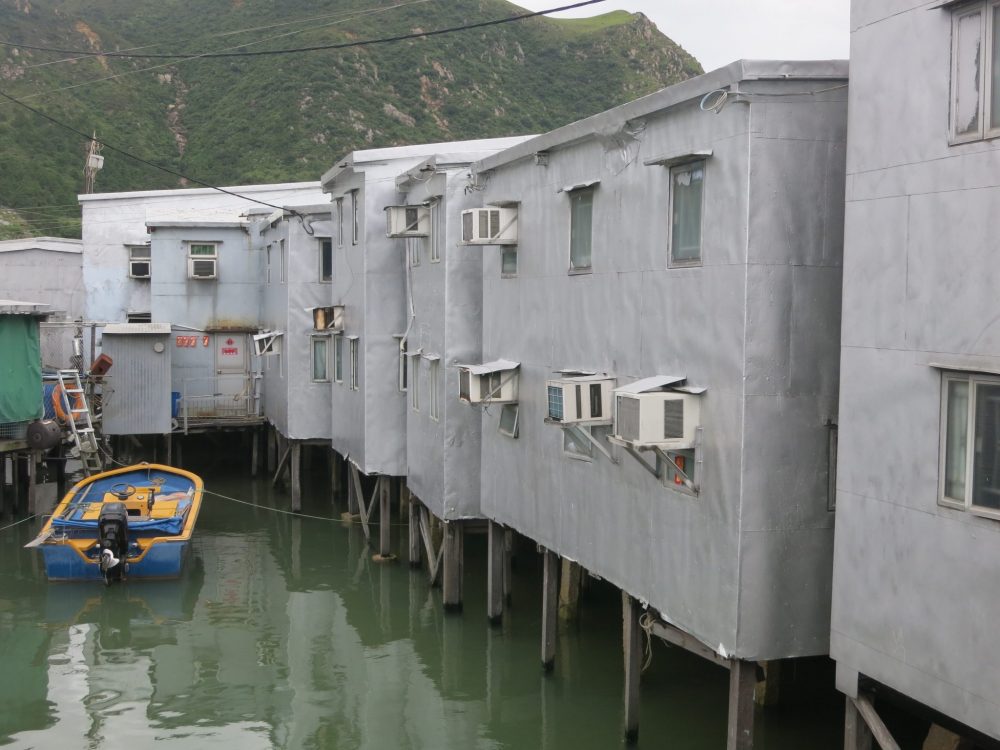
Rebuilding Tai O, Hong Kong
The village experienced a devastating fire in 2000 and many of the original wooden buildings were destroyed. They were rebuilt, but the new buildings seem only marginally better than the older buildings, since they appear to be made of metal, painted in silvery grey. In the places where the paint has peeled off, the metal is rusting. Wouldn’t a metal house be incredibly hot?
All of the houses seem fragile, like a strong wind would blow them away. They have monsoons in Hong Kong, and I wondered how many would survive the next one.
You might also enjoy reading these articles:
My impressions of Tai O village
The sanitation situation as well seemed lacking. As I sat on the balcony of a teahouse waiting for my tea, I surveyed the group of houses across the water from me. The sound of running water drew my attention to one of them, and I saw that a large pipe was emptying into the water below the house. A moment later, a smaller amount of water exited another nearby pipe. Someone had just used the toilet and washed his or her hands.

Every place where the water wasn’t moving—the corners, as it were—had accumulated a collection of floating trash: plastic bags, bottles, and so on. On land, too, many houses were surrounded by assorted junk: rusted bicycles, defunct washing machines, all sorts of bits and pieces.
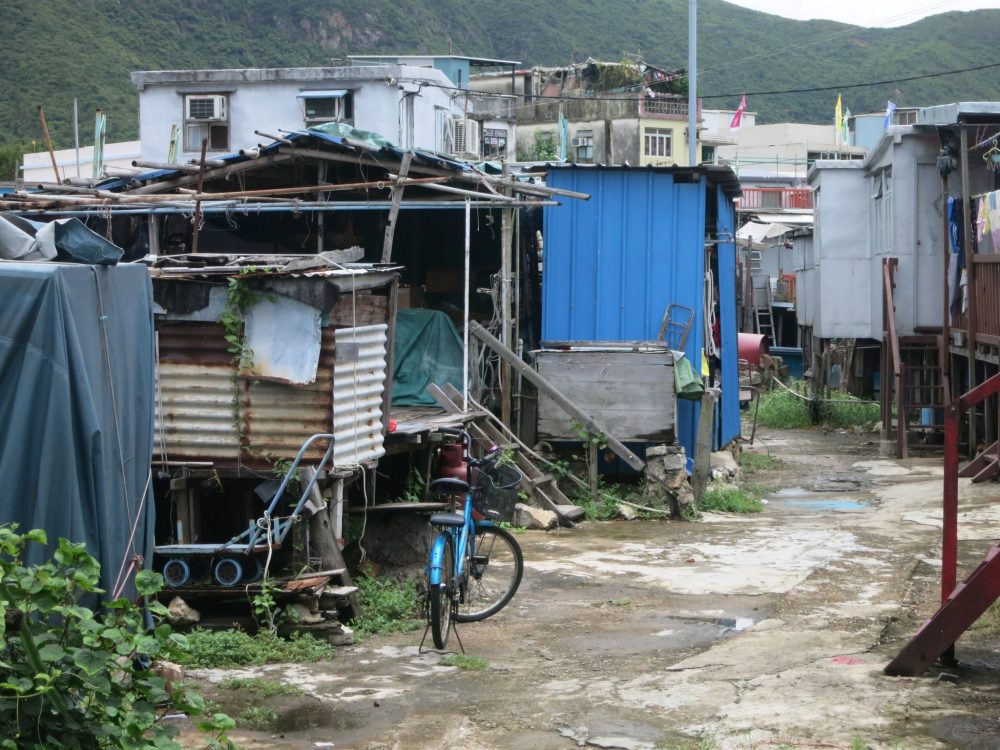
Nevertheless, I enjoyed my stroll around the village. Some of the houses are on dry land, and some, like the teahouse where I stopped, sit with one edge on dry land and the bulk of the building on stilts over the water. It was a hot day, and elderly people had left their doors open for air, allowing me to have a quick peek into their lives.
On the main roads—really just walking paths—the primary business was seafood: mostly dried fish and other creatures. I couldn’t identify most of what I saw, and since I wasn’t shopping, didn’t stay long to look.
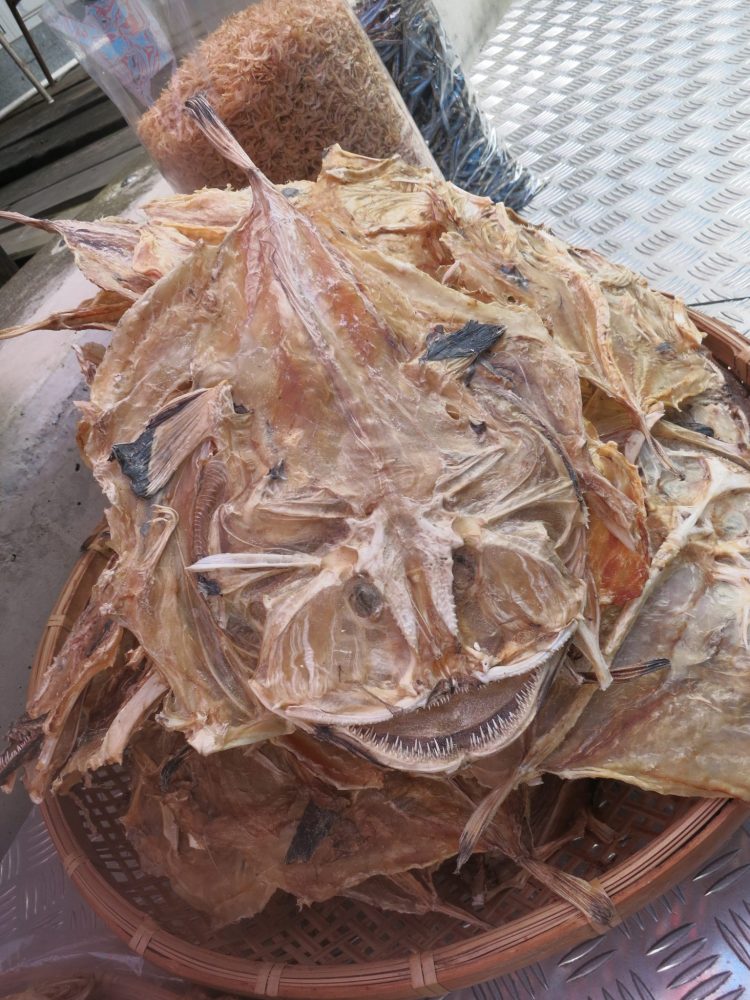
Poverty tourism?
Do I recommend visiting Tai O village in Hong Kong? I like to get off the beaten path, but had mixed feelings about this place. As a tourist, I enjoy the picturesque, but part of me wants a more comfortable picturesque-ness. What I mean is, for example, visiting the Baix Empordà region in Spain, and knowing that all those houses that my mother would have called “cute” or “quaint” are likely perfectly livable inside, with running water and good sanitation and indoor toilets.
You could call the houses in Tai O pretty, but only from a distance. How is this any different from going to visit a slum in, say, Mumbai or Rio de Janeiro? Isn’t it “poverty tourism”?
Book your Hong Kong accommodations here.
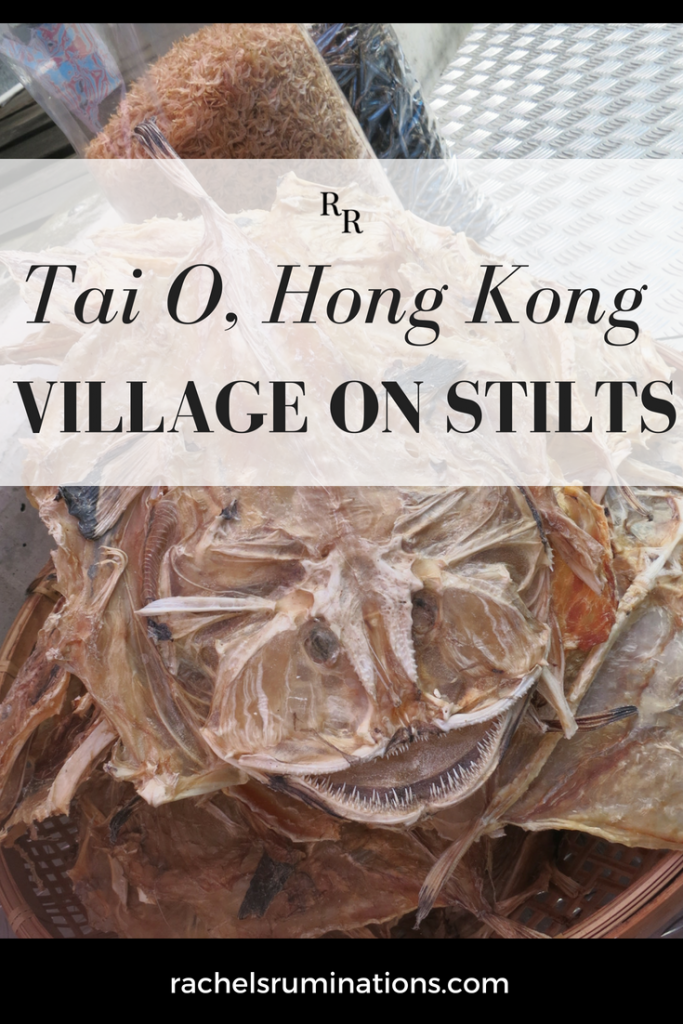
Visiting Tai O village, Lantau Island, Hong Kong
By bus: To get to Tai O, I took bus 11 from the Tung Chung MTR metro station. It climbed and then descended disturbingly fast down narrow, mountainous roads. Fortunately, the paving was good, if not the driving. it takes about 45 minutes.
You can also take a ferry from Central Pier (number 6) to Mui Wo and then take bus 1 (about 45 minutes total).
By ferry: Another option is to avoid riding that scary bus is by taking a ferry. There’s one that goes this route: Tuen Mun – Tung Chung – Sha Lo Wan – Tai O. The whole route takes about 53 minutes if they use their usual fast ferry, and 87 minutes if they sub in a regular ferry. Not all of the boats on this route stop at the interim stations, just traveling straight from Tuen Mun to Tai O in about an hour. You can check schedules here.
Alternatively, you could sign up for a tour, most of which include other sights on Lantau Island such as the Big Buddha. Click on the images below:
Updated September 3, 2024. I haven’t been back to Hong Kong since I wrote this article back in 2015, but I’ve checked online, and it doesn’t look like much has changed, though perhaps it’s more touristy than it was then. I’ve updated the transportation information, but that’s all. Please add any comments or additional information in the comment section below!
If you enjoyed this article, please share it with others through whatever social media you prefer. The following images are formatted for Pinterest.
My travel recommendations
Planning travel
- Skyscanner is where I always start my flight searches.
- Booking.com is the company I use most for finding accommodations. If you prefer, Expedia offers more or less the same.
- Discover Cars offers an easy way to compare prices from all of the major car-rental companies in one place.
- Use Viator or GetYourGuide to find walking tours, day tours, airport pickups, city cards, tickets and whatever else you need at your destination.
- Bookmundi is great when you’re looking for a longer tour of a few days to a few weeks, private or with a group, pretty much anywhere in the world. Lots of different tour companies list their tours here, so you can comparison shop.
- GetTransfer is the place to book your airport-to-hotel transfers (and vice-versa). It’s so reassuring to have this all set up and paid for ahead of time, rather than having to make decisions after a long, tiring flight!
- Buy a GoCity Pass when you’re planning to do a lot of sightseeing on a city trip. It can save you a lot on admissions to museums and other attractions in big cities like New York and Amsterdam.
Other travel-related items
- It’s really awkward to have to rely on WIFI when you travel overseas. I’ve tried several e-sim cards, and GigSky’s e-sim was the one that was easiest to activate and use. You buy it through their app and activate it when you need it. Use the code RACHEL10 to get a 10% discount!
- Another option I just recently tried for the first time is a portable wifi modem by WifiCandy. It supports up to 8 devices and you just carry it along in your pocket or bag! If you’re traveling with a family or group, it might end up cheaper to use than an e-sim. Use the code RACHELSRUMINATIONS for a 10% discount.
- I’m a fan of SCOTTeVEST’s jackets and vests because when I wear one, I don’t have to carry a handbag. I feel like all my stuff is safer when I travel because it’s in inside pockets close to my body.
- I use ExpressVPN on my phone and laptop when I travel. It keeps me safe from hackers when I use public or hotel wifi.




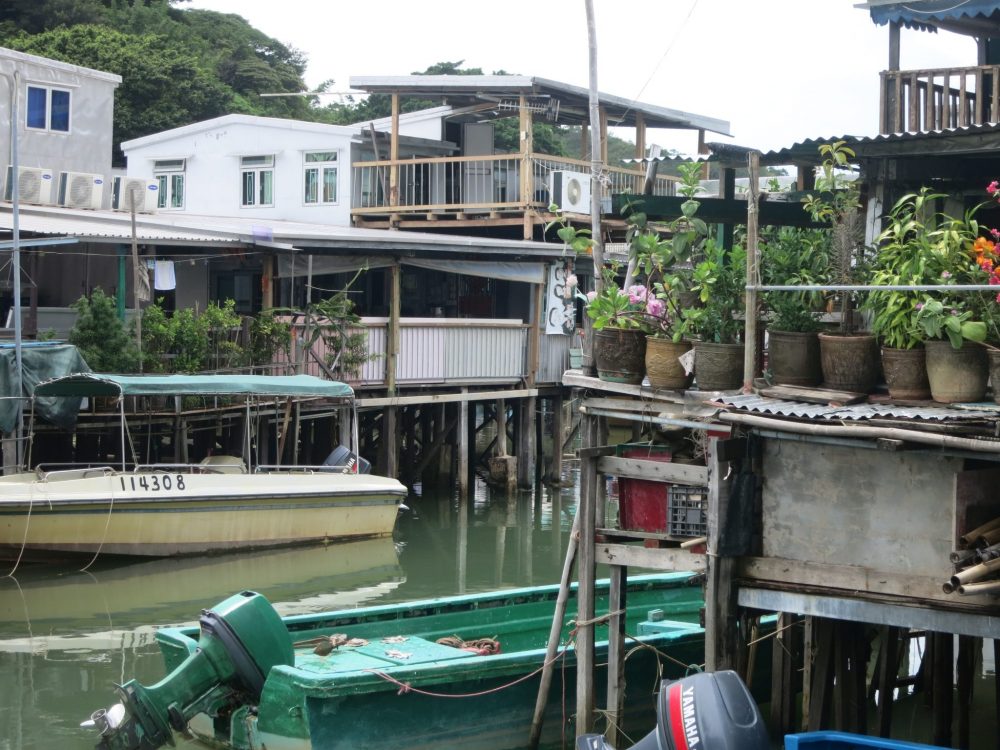

It’s how I feel about tonle sap in Cambodia – only the poorest live here and the conditions must be terrible as you pointed out. Wow! I assumed all of Hong Kong was gleaming high rises and had no idea this side existed to the city. It’s definitely not advertised. BTW, that dried fish head will haunt my nightmares tonight. thanks.
Haha! It’s pretty fierce looking, isn’t it? I haven’t been to Cambodia, but sometimes I question what I’m doing when I travel to a very poor place. It sometimes feels like visiting a zoo, or slowing down to stare at a car crash. Do I want to be that kind of comparatively wealthy person who looks at how poor people live and calls it ‘charming’ or ‘quaint’? Marie Antoinette had a ‘cottage’ where she could pretend to be a peasant. I visited a castle in Seoul which had a small field and a rice paddy for the king and queen to cultivate. Hmm, I feel a new post coming on…
I know what you mean about having mixed feelings upon your visit to Tai O. While westerners hate to think of ourselves as privileged voyeurs (and the whole discussion of ‘privilege’ and its associated guilt is another topic altogether), the fact is that, by comparison, we are. But the real question is can we suspend the comparison sufficiently to absorb something from the people and their culture worthy of sharing and learning. I think it’s fine to have preferences when traveling for sanitary conditions and the like, too. It’s good to talk about the complex reactions we all have with the candor you have used in this post.
Thanks for your thoughtful comment, Betsy. I certainly think this is an important discussion: travel and its purposes, its effects, etc. For me, personally, I’ve traveled in poor countries quite a bit, and always end up coming back to this question and this feeling of guilt. There’s a Dutch phrase for what this sort of tourism could be called: “aapjes kijken” which means, literally, “looking at the apes.” In other words, it’s treating local people like animals in a zoo. Not a positive expression.
This becomes the great ethical and moral issues that travel brings up. It also brings up a guilt trip for me personally. We have traveled extensively through Asia, and there have been to places just like this in Cambodia, Sabah etc that sit alongside ritzy resorts, and that just seems wrong on so many levels.I think however that what we saw along the Tonle Sap for example, were happy people.Kids jumping in and out of the water and playing games with one another. Women washing one another’s hair, in less than what we would consider good conditions. I don’t have answers, just reactions.
Yes, I’ve remarked the same thing, especially on my travels in Africa. People don’t need much to be happy. They just need to be healthy and have enough to eat and safe water to drink and to have the people they love around them. But that doesn’t really address our role as privileged tourists going there to see them and how they live. I also don’t have answers!
I had no idea there had been such a devastating fire in Tai O! I visited the town in 1995 prior to the airport being built and the handover to China. At the time it was very picturesque with colourful wooden homes, a food market and sampans floating past. No garbage at all. I enjoyed a wonderful fish lunch and then met a mask maker who was carving intricate masks from bamboo in his home. I’m so sorry to hear of Tai O’s decline. Thanks for your honest reporting on Tai O
Wow, I’d have loved to see it then! And I’d be very interested to hear your reaction if you ever go back there! I mean, maybe your “colorful wooden homes” are the same ones I’m seeing as borderline shacks. Maybe our standards are just different…
This reminded me somewhat of our visit to the hutongs of Beijing. A saving grace: Tai O offers a glimpse of China as it used to b.e
Yes, that’s true. I have another post coming soon about Pulau Ubin, which is an island of Singapore that’s supposed to be like Singapore was 50 years ago. It’s a shame when these older ways disappear entirely.
Tai O village on Lantau Island in Hong Kong sounds so depressing. I can relate with what you said about tourism; what are we looking for — is some reality too much? I don’t have the answer, but it is sad it is the way they must live.
It didn’t feel depressing when I went; I just wondered at the apparent poverty. I can’t even be sure of that, since I couldn’t see inside the houses at how people live there. Perhaps to them it’s far more desirable than living in crowded Hong Kong itself. It’s a problem with traveling; we’re perpetual outsiders no matter how much we try to stay in Airbnb places or chat up the locals.
You certainly explored Hong Kong off the beaten path. When I was there many years ago I was partly on business which led me into many of the outer districts, which are all far removed from the glitz of downtown. These are more authentic places and put the public image of a destination into better context. I usually like to explore such environments, as they provide much more of an insight into the life of ‘normal people’.
I enjoy both. Popular sightseeing spots like Victoria Peak are usually popular for a reason. But, yes, I like to get a look at where the “real people” live too!
Thanks for a peek into untouristy Lantau Island in Hong Kong. I’ve seen similar villages on stilts in other countries and found them quite interesting. I might check it out next time I’m in the area but the Big Buddha is still higher on my long list.
You could do both in one day quite easily. There are buses between them, but take the cable car in one direction or the other!
We visited Tai-o a few times when we lived in HK many, many years ago. It is a great place to go and realise how diverse the world is.
Yes, it is! Thanks for commenting, Lyn!
I do feel uncomfortable when I feel as though I’m “gawking” at poverty. Even if the people seem healthy and happy, I am so obviously from somewhere else and so obviously there just to “see”.. Visiting the townships in South Africa definitely brought up some of these queasy feelings, that I was an intruder. OTOH, when I was 9, we lived in Mexico for a year. My sister and I ended up at the public school for girls who couldn’t afford to go to the Catholic school which had a better academic reputation, but wasn’t free. Our school didn’t even have uniforms, probably because that would have made attending school cost prohibitive for many of the students. We were clearly the only gringas, but I didn’t feel like an intruder. Actually, in that situation we were perhaps the gawkees rather than the gawkers, especially when they trotted us out to sing the Mexican national anthem for some visiting local officials. I think finding a way to belong is a huge benefit of slow tourism or of having a reason for being there. (Am I remembering correctly that you were in the Peace Corps?)
Yes, I was in the Peace Corps in Malawi, and you’re right, I was both gawker and gawkee. People stared at me wherever I went except the big cities where there were other whites. In villages small children were terrified of me and bigger children would want to touch me to see if the white would rub off. Certainly within my own school community (I was a teacher at a secondary school.) I did attain a measure of belonging (though never entirely) because I was just one of the teachers. But if you don’t settle in a place and stay for a long time, you never belong. You’re always a tourist, i.e. the gawker.
I think it’s always tricky when traveling in a place with very different economic standards and expectations from our own. Part of it is our own attitude: why are we there? To learn or just to gawk? Part of it depends on how the residents themselves feel about it – where they are mostly proud of their community and how they manage to live (even if they are really poor) touring and seeing how they live seems ok to me. In places where most people are embarrassed or ashamed of how they live, it’s definitely not ok. I’ve been in both and the difference is pretty stark. And, of course, sometimes those two live side by side, which is when I think it really gets hard.
I don’t think the issue is really that people are embarrassed or ashamed of their poverty. It’s that we privileged world travelers come and stare at them and take pictures of their homes, as if they are animals in a game park. I know a lot of travelers would say “Yes, but I try to meet locals and interact with them,” but I generally wonder how superficial such a short-lived interaction must be. On the other hand, we do spend money in such places, which the locals want, so perhaps this is the price they have to pay…
I may pass on the dried fish.
Poverty tourism, interesting term, certainly humbling.
Thanks again for another great share Rachel.I can experience some of the worlds corners vicariously through your eyes.
Happy travels!
K